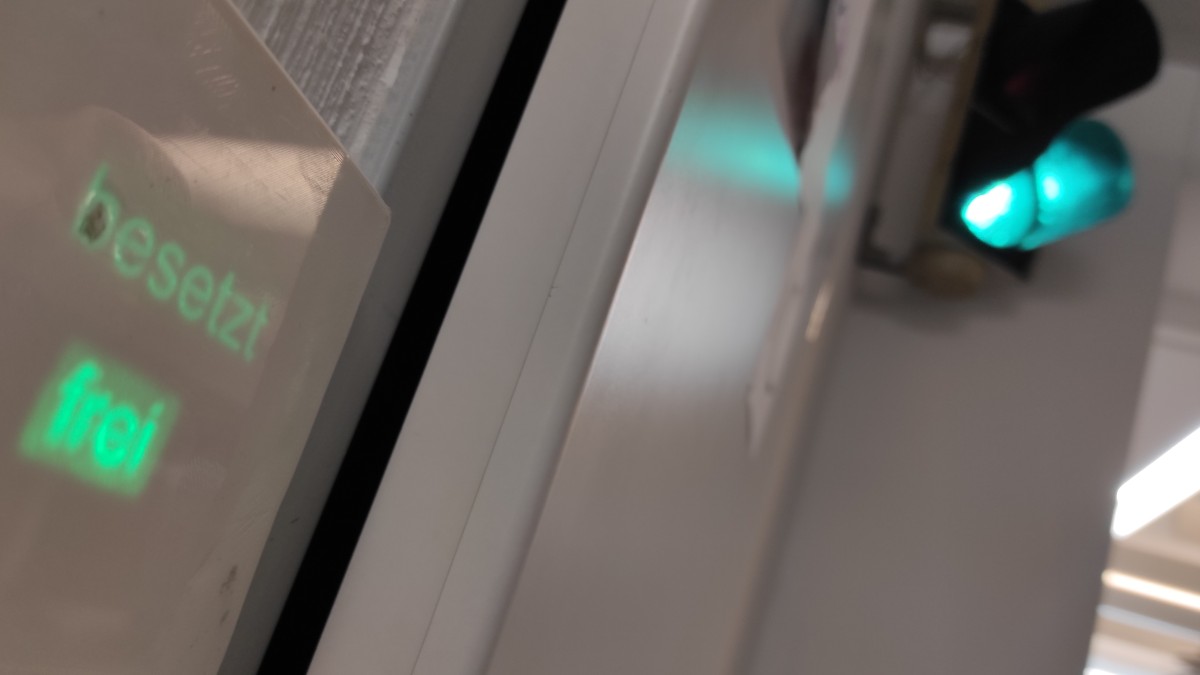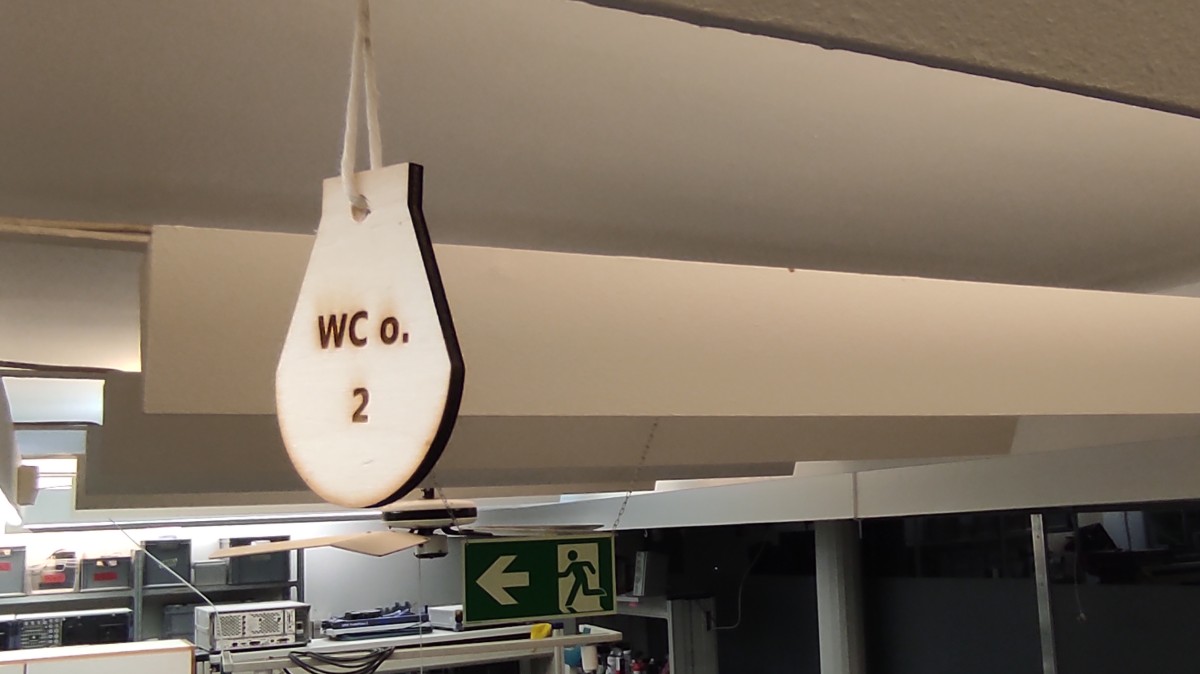We just celebreated our first new year’s eve in the new space, December and the year-end sprint that came with it are over. Time for a look back!

December is always a special month, what with all the holidays, christmas and new year’s celebrations and of course due to Chaos Communication Congress. Accordingly, we “only” had eleven public events. Maker Monday alone managed to pull 25 recurring and new participants into our venue. The monthly Nähcafé (Sewing Cafe) together with Hochschulgruppe für Nachhaltigkeit has also become a fixture of our programming. Four Live Let’s Plays invited to dive into gaming culture, The Things Network/LoRaWAN met twice publicly, and anybody interested in ITSec could participate twice at the Capture the Flag get-togethers. Last, but not least, the local OpenStreetMap-Community met for their Stammtisch in our rooms.
Remodeling and final Grant preparations
All these public events were surrounded by a lot of work that already began in November and entered into an even busier phase in December. As already mentioned, we managed to get a grant from DSEE that allows us to procure materials and appliances that we’re still missing. And while November saw us listing all the requirements and comparing vendors, literally every day in December somebody from our procuring team was present to accept deliveries, unpack them and enter the new things into our inventory system.

Some of the procurements are meant for the building infrastructure itself that we use together with Haus der Nachhaltigkeit. While we prototyped an infoscreen near the main entrance in October, this has been turned into a fixed installation in the mean time. The screen shows the floor plan and any upcoming events, making it easy to see where to go. And another “status monitor” has been installed: A former pedestrian traffic light and a DIY LED indicator make it easy to see from afar whether the accessible toilet at the ground floor level is available or occupied.

The lighting within the building has been a challenge from the get-go. The building used to be a sporting-goods shop, where all the available lighting was simply switched on from two central points in the morning, and then switched off again at night. That is perfect for a store – but selectively switching individual groups of lights on or off from rows of deceptively labeled switches with no visual connection to the fixtures proved to be difficult. Because, of course, we would like to only use electricity for lighting where light is actually needed. Literally overnight Seppi took up the task (again) and laser cut pendant labels for each fixture group to make clear which switch belongs to which lights.

Just like the former rooms at Weinhof in Ulm, the former SpoSo-building is filled to the brim with fluorescent lighting: The initial count in May 2023 ended up with over 250 individual fluorescent tubes. And just like at Weinhof, this meant quite the headache for us. After all, the EU implementing their European Ecodesign Initiative meant a total sales ban of the typical T8 tubes by August 2023. Sooner or later, defective tubes would have had to be replaced with LED replacements anyway.
Therefore, we and HdN had already decided in May to not only replace and upgrade already defective lights or those that looked to be near the end of their life, but to modernize whole groups of fixtures that are regularly used. This had a real impact on energy consumption: Before, even the “small” (and heavily used) passage lighting in the woodworking workshop used around 200 watts of power. After modernizing the workshop, even the full lighting for the whole room needs only 220 watts – and at the same time, the lighting is much brighter than before.
The grant from DSEE allowed us to expedite modernizing the rest of the fixtures that still remained. About 100 linear fluorescent lights were still on the to-do list. We now have the neccessary parts to modernize them and will continue upgrading the remaining lights in the coming weeks. This will save us significant energy costs in the future!
Meanwhile, this is just the “boring” infrastructure part. Much more interesting are all the new machines and extensions of our capabilities – but we want to reserve them the place and space in their own posts in the future :)
We want to continue our youth work!
Events for up-and-coming hackers and the “Jugend hackt” programming are tightly woven into our community. The student volunteer group that brought Jugend hackt as one of the (back then) four regional events to Ulm in 2015 was the initial seed for the idea to establish a hack- and makespace downtown for all of our activities. Due to our forced moving out of Weinhof and the cancellation of the funds for Jugend hackt lab at the request of Ulm’s CDU faction, we had not been able to offer programming for young people for a while. Since we restarted our activities at the new space, however, re-invigorating this programming has been high on our list of priorities. Therefore, Eli participated at the networking event for all Jugend hackt organizing teams in December in Leipzig.

Besides the mandatory visit at dezentrale, one of Leipzig’s hackspaces, the regional organizing teams spent the weekend exchanging their experiences at “Urban Jungle”, a coworking space in Leipzig. And Eli was able to pick up a lot of ideas how we can’t only make use of our list of already existing workshop ideas for a restart of Jugend hackt Lab, but also what kind of ideas for civic education we could incorporate even more into our programming.
This is because, of course, Jugend hackt is not only about being able to find one’s way around technology. From the get-go, a critical perspective towards the role of technology, code and the structural power that comes with them is a crucial part of what we’re doing. This self-efficacy, especially in the context of formerly powerful institutions has not only been part of the themes of the events over the years.
Ending the year at the 37. Chaos Communication Congress in Hamburg and New Year’s in our shared space
Besides the final push surrounding the grant and the procurements, there was yet another opportunity for networking, where Jugend hackt also played a role: For the first time since 2019, there was another Chaos Communication Congress, and of course 37C3 saw a delegation from us (albeit with another new name) – just like at many Congresses before.

Wedged in between Christmas and New Year’s, Congress Centrum Hamburg became a nearly magical place again, as one can imagine when seeing the photos. At the behest of Jugend hackt, Eli offered a printing workshop for anybody who did not only attend conference talks but wanted to do things with their hands as well. Originally, the workshop was only planned for Junghacker*innentag but the demand for art and printing using our own 3D-printed OpenPressProject printing presses was so high, that Eli added two more workshop days. People could carve their own linoleum or tetrapak printing masters to take away custom keepsakes from Congress.

While this congress did not see the customary, large WikiPaka-WG that we used to contribute to, our activists were not only to be found at the youth assembly – where the printing workshops took place – but also at the directly adjacent Bits-und-Bäume habitat. This habitat was the home bases for groups surrounding Free Knowledge such as OpenStreetMap and Wikipedia. That was a great incentive to do even more at 38C3!
Both for the people returning from Hamburg during New Year’s eve as well as anybody who stayed home, the rooms of temporärhaus and Haus der Nachhaltigkeit proved to be the perfect place to spend the evening, recall the past year and celebrate the beginning of the new year. Who could have imagined that just one year earlier?

Because the past year was really eventful. In January, the local press interviewed us (and another space in Ulm) about our plans for 2023. And we really checked all the boxed from back then: We had wished for a new venue, wanted to reinvigorate Jugend hackt in our City and keep up the banner of a counter-model to glossy facades surrounding tech and digitization. One move, one outstanding opening party and – coincidentally! – 42 public events in 2023 later, we can proudly say: That went rather well :)
